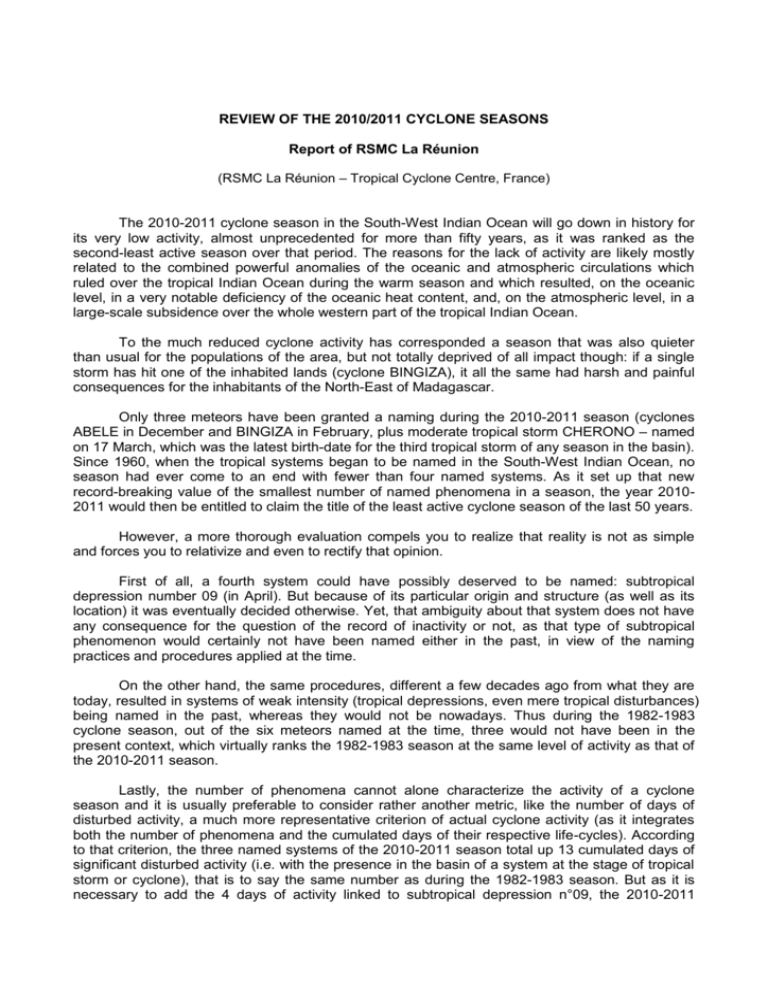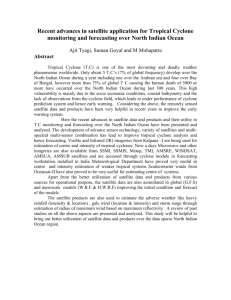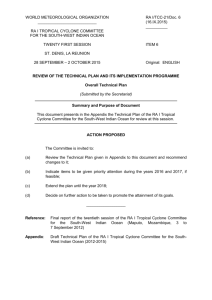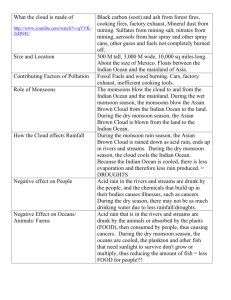2010-2011
advertisement

REVIEW OF THE 2010/2011 CYCLONE SEASONS Report of RSMC La Réunion (RSMC La Réunion – Tropical Cyclone Centre, France) The 2010-2011 cyclone season in the South-West Indian Ocean will go down in history for its very low activity, almost unprecedented for more than fifty years, as it was ranked as the second-least active season over that period. The reasons for the lack of activity are likely mostly related to the combined powerful anomalies of the oceanic and atmospheric circulations which ruled over the tropical Indian Ocean during the warm season and which resulted, on the oceanic level, in a very notable deficiency of the oceanic heat content, and, on the atmospheric level, in a large-scale subsidence over the whole western part of the tropical Indian Ocean. To the much reduced cyclone activity has corresponded a season that was also quieter than usual for the populations of the area, but not totally deprived of all impact though: if a single storm has hit one of the inhabited lands (cyclone BINGIZA), it all the same had harsh and painful consequences for the inhabitants of the North-East of Madagascar. Only three meteors have been granted a naming during the 2010-2011 season (cyclones ABELE in December and BINGIZA in February, plus moderate tropical storm CHERONO – named on 17 March, which was the latest birth-date for the third tropical storm of any season in the basin). Since 1960, when the tropical systems began to be named in the South-West Indian Ocean, no season had ever come to an end with fewer than four named systems. As it set up that new record-breaking value of the smallest number of named phenomena in a season, the year 20102011 would then be entitled to claim the title of the least active cyclone season of the last 50 years. However, a more thorough evaluation compels you to realize that reality is not as simple and forces you to relativize and even to rectify that opinion. First of all, a fourth system could have possibly deserved to be named: subtropical depression number 09 (in April). But because of its particular origin and structure (as well as its location) it was eventually decided otherwise. Yet, that ambiguity about that system does not have any consequence for the question of the record of inactivity or not, as that type of subtropical phenomenon would certainly not have been named either in the past, in view of the naming practices and procedures applied at the time. On the other hand, the same procedures, different a few decades ago from what they are today, resulted in systems of weak intensity (tropical depressions, even mere tropical disturbances) being named in the past, whereas they would not be nowadays. Thus during the 1982-1983 cyclone season, out of the six meteors named at the time, three would not have been in the present context, which virtually ranks the 1982-1983 season at the same level of activity as that of the 2010-2011 season. Lastly, the number of phenomena cannot alone characterize the activity of a cyclone season and it is usually preferable to consider rather another metric, like the number of days of disturbed activity, a much more representative criterion of actual cyclone activity (as it integrates both the number of phenomena and the cumulated days of their respective life-cycles). According to that criterion, the three named systems of the 2010-2011 season total up 13 cumulated days of significant disturbed activity (i.e. with the presence in the basin of a system at the stage of tropical storm or cyclone), that is to say the same number as during the 1982-1983 season. But as it is necessary to add the 4 days of activity linked to subtropical depression n°09, the 2010-2011 season must be considered as not being equivalent to the 1982-1983 season, which therefore remains the season that may be deemed as the really least active of the last 50 years. An objective analysis of the archives hence leads to the conclusion that the title of the season with the smallest number of named phenomena would – de facto – go to the 2010-2011 season, but the latter would not for all that establish a new record of low activity (which would still belong to the 1982-1983 season), simply becoming the second-least active cyclone season in 50 years. The decreasing trend of the disturbed activity which has been observed for the last three years, has therefore been going on this year, so much so that it led to an almost historic low level. The following question must then naturally be asked: “what are the reasons that could explain that exceptional weakness of the cyclone activity in the South-West Indian Ocean?” Generally speaking, to break records, there must be exceptional circumstances, or a combination or a series of facts notably departing from the norm. In that case, if we cannot be absolutely sure about the reasons for that exceptional listlessness of the cyclone activity over the South-West Indian Ocean basin, the conjunction of two factors may nevertheless be suspected: a global context and a more particular factor peculiar to this year, namely the very special climate conditions prevailing over the whole Indo-Pacific zone, during the 2010-2011 warm season in the southern hemisphere. The global context is that of the quite significant decrease in the cyclone activity observed for 4-5 years world-wide. If the decline of the activity which has been taking place during the last few years in the North Pacific had a prevailing influence on that decrease, it is in fact a rather general tendency, the Atlantic basin being a real exception. Thus it is the third consecutive season that the South-West Indian Ocean has experienced a low level of activity. That global deficiency has brought back the world-wide cyclone activity to a level that had never been known for about thirty years and since the preceding major slack period of inactivity at the end of the seventies. Whether it is a simple decennial or multi-decennial natural cycle, or the sign of a deeper and lasting change, the reasons for that current bout of fainting fit of the global cyclone activity remain unknown at present. To that acknowledged fact of a global decreasing trend observed over several years, have been affixed specific circumstances peculiar to the 2010-2011 warm season, and related to the unusual situation which prevailed over the whole Indo-Pacific area, where there was an important anomaly of the atmospheric circulation. The latter resulted in a modification in the zoning and intensity of the upward and subsident branches of the cells associated to the Walker circulation. As the main consequence, it generated abnormally moist conditions in the eastern tropical Indian Ocean as far as the South-West Pacific, hence excessive rainfall over Indonesia and Australia (in Australia the period from September 2010 to March 2011 was the wettest on record – 100% above average) and induced widespread and disastrous flooding (Brisbane in southeast Queensland had its worst floods since 1974), and a sustained cyclone activity around the latter (but eventually simply in accordance with the climatologic norm); whereas, on the contrary, abnormally dry conditions and quiet conditions in terms of disturbed cyclonic activity, prevailed over the western part of the Indian Ocean and the central Pacific. Eastern Africa paid a heavy toll for the extreme drought that resulted (the town of Wajir, in northeastern Kenya, only received 73 mm of rain between October 2010 and September 2011, its driest 12-month period in the post-1950 era). This drought, rated as one of the three most severe droughts of the last 60 years over eastern and northern Kenya, was to be blamed for the awful famine that wreaked havoc in the African Horn. But it is worth noticing that at the same time most of southern Africa benefited from surplus rainfall (with some flooding occurring on several occasions as a counterpart). Thus, rainfall from JanuaryMarch 2011 was two to four times the average over many parts of a region encompassing parts of South Africa, Zimbabwe, Botswana, Namibia and Angola. That aforementioned atmospheric anomaly was coupled with an oceanic anomaly. Both were under the influence of a particularly powerful La Niña event (one of the most intense of the last six decades) which had rapidly developed during the 2010 austral winter (and had thus followed the El Niño conditions of the 2009-2010 summer). Of course the La Niña primarily rules over the equatorial and tropical Pacific, but it also contributed to affect and modify the atmospheric circulation far beyond, in particular over the Indian Ocean, whereas on the oceanic level, the prominent cooling of the central and eastern Pacific waters associated with La Niña, came along with a warming up of the waters in the Australian region. At the same time, the end of that austral winter witnessed the development of a negative phase of the Indian Ocean Dipole (IOD), which then reached its climax in October, before rapidly weakening (in a rather classic way). Manifesting through a warming up of the waters of the eastern Indian Ocean, in the vicinity of Indonesia, that negative phase of the IOD combined with the effects of La Niña to generate strong warm anomalies over the whole oceanic region of the South-East Indian Ocean (anomalies frequently exceeding +2°C between Indonesia and Australia for the sea surface temperatures). On the atmospheric level, the negative phases of the Indian Ocean Dipole are usually associated with westerly wind anomalies in the near-equatorial zone of the Indian Ocean. That was actually observed during the 2010 episode, with a westerly wind anomaly in low troposphere, particularly strong over the East of the basin. But above all, that westerly wind anomaly lasted long after the end of the negative phase of the IOD, and persisted during the whole warm season (until April 2011). It reached a peak between 20 November 2010 and 20 January 2011, with westerly wind anomalies reaching 20 knots over the South-East Indian Ocean on monthly average. As the ongoing La Niña episode brought about at the same time easterly wind anomalies over the nearequatorial western Pacific, an exacerbated convergence settled on a long term basis on a large scale in low troposphere over the whole area around Indonesia and Australia (the counterpart in altitude being a strong divergent anomaly). The large-scale upward motion which resulted from it brought about an increase in the cloud covering and the convective activity over a wide area extending from southern Asia to Australia, with excess rainfall (making 2011 the Australia’s second-wettest calendar year since national rainfall records began in 1900 – the wettest year remaining 1974, also a La Niña year). To that enhanced upward branch of the Walker circulation corresponded subsident branches that were also boosted, both over the central and eastern Pacific and the western Indian Ocean, where subsidence reached its culmination in January. That marked subsidence logically had a hampering influence on the cloud and convective activity, and, as an indirect consequence, on the cyclone activity, which, in fact was almost non-existent for two months between December and early February. This being said, if the preceding explanation clearly makes sense, it would be risky to try and extrapolate generalities from it. Thus, attempting to try and establish a supposed link between an ongoing La Niña episode over the Pacific and the cyclone activity over the South-West Indian Ocean will very soon lead to a dead end. As a matter of fact, if one looks at the past, one notices that during the La Niña years, no clear tendency emerges: anything may happen in terms of cyclone activity over our basin, even a cyclone activity above the average, as was the case during the 1988-1989 season, the last occurrence of a La Niña event whose magnitude can compare with that of 2010-2011. Ditto if one focuses more specifically on the cyclone seasons associated with La Nina episodes and preceded by a negative phase of the Indian Ocean Dipole. Since 1958 there have been four other years of the same type: in 1964, 1971, 1974 and 1975. The last three mentioned were followed by cyclone seasons that could be qualified as almost normal over the South-West Indian Ocean, whereas the 1964-1965 season ranks among the most active of the last 50 years. There is no comparison with the year 2010-2011 hence. Finally, it should incidentally be recalled that the reference year in terms of inactivity, the 1982-1983 season, which was previously mentioned several times, was under the influence of a major El Niño event… Once again all this highlights the extremely low predictability of the cyclone activity over our basin, even in the presence of very strong and conspicuous climate signals, both for the austral oscillation and the Indian Ocean Dipole. However, an additional important element attracts our attention: during almost the whole atypical 2010-2011 warm season, the oceanic heat content remained much below normal over most of the tropical Indian Ocean lying between latitudes 5 and 15°South and to the west of longitude 90°East, i.e. over the usual cyclogenesis area where the great majority of the storms of the South-West Indian ocean basin form (including in particular the privileged cyclogenesis area corresponding to the sector situated to the south of the Chagos Archipelago). Whether that powerful negative anomaly of the oceanic heat content (much more spectacular than the one exhibited by the sea surface temperature) took place in connection or not with the settling of strongly subsident atmospheric conditions over the basin (and of equatorial westerly winds abnormally strong over the East of the Indian Ocean), there is no doubt that it played a major part in the notable weakness of the cyclone activity over the South-West Indian Ocean, as it certainly accounted to a large extent for the total absence of cyclogenesis observed this season within the wide zone to the south of the Chagos (between longitudes 65 and 85°East). __________






